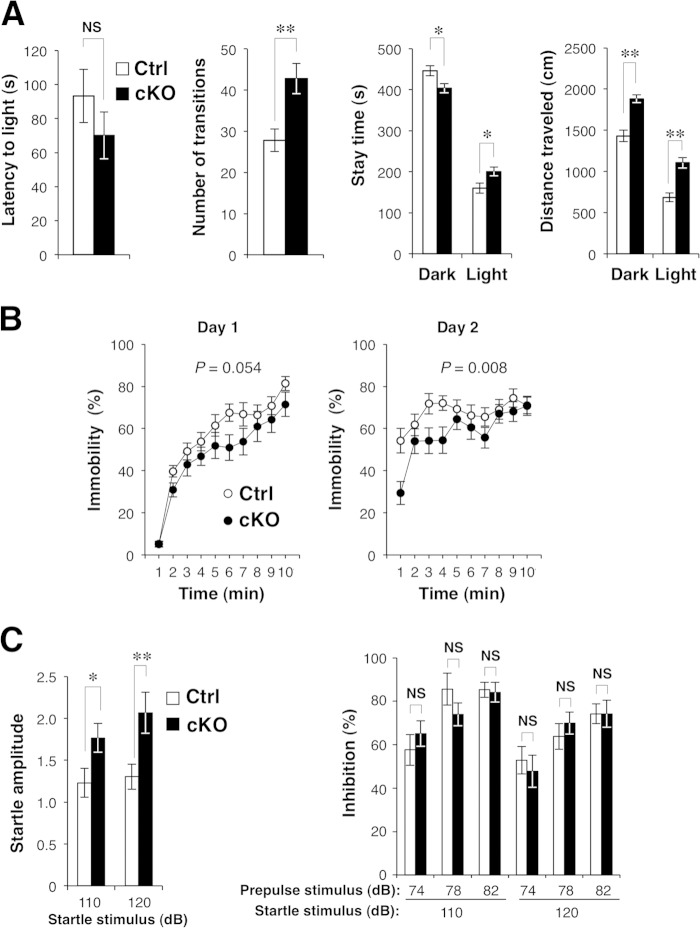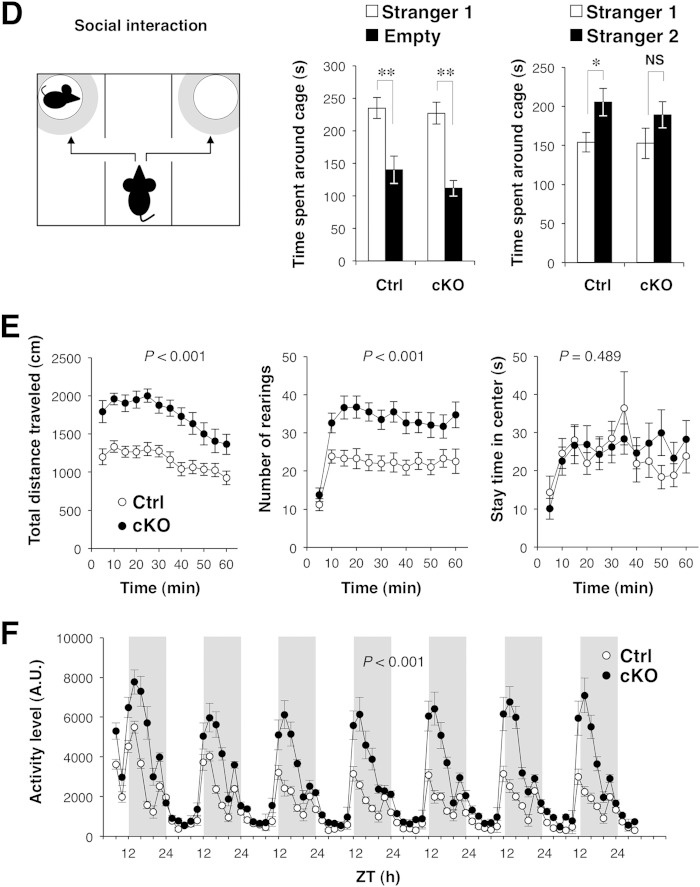FIG 2.
Behavioral analyses of Shp2 cKO mice. (A) Light-dark transition test. Shp2flox/flox (control [Ctrl]) or Shp2 cKO mice were allowed to move freely between two equal-size chambers (21 by 21 by 25 cm) connected by a door. One chamber was illuminated at 390 lx, whereas the other was dark (2 lx). At the start of the test, a mouse was placed in the dark chamber and its behavior was monitored for 10 min. The latency to the first entry into the light chamber, the total number of transitions between the two chambers, the time spent in each chamber, and the total distance traveled (left to right panels, respectively) were recorded automatically. (B) Porsolt forced-swim test. Mice were subjected to the forced-swim test in a Plexiglas cylinder filled with water to a height of 7.5 cm. The animals were subjected to the same test twice with a 24-h intertest interval (left and right panels, respectively), and their behavior was recorded with a CCD camera. Immobility was determined automatically from the images, and immobility time is expressed as a percentage of each 1-min interval. (C) Acoustic startle response (ASR) and prepulse inhibition (PPI). The ASR and PPI were measured with an automatic startle reflex recording system. Mice were placed in a Plexiglas cylinder and left for 10 min without stimulation. A 110- or 120-dB startle stimulus was then delivered for 40 ms either alone (left panel) or 40 ms after a 40-ms prepulse stimulus of 74, 78, or 82 dB (right panel). The amplitude of the ASR is expressed in A.U. The magnitude of PPI was determined as the percent decrease in the startle response after exposure to a prepulse compared with the startle response to the pulse alone. (D) Crawley-type (three-chamber) social interaction test. Social interaction of mice was measured automatically with an apparatus consisting of three chambers (left panel). A mouse was placed in the central chamber and allowed to move freely among the three chambers for 10 min. A lattice cage was then placed in a corner of both the left and right chambers, and a stranger mouse (stranger 1) was placed in one of the cages whereas the other cage was left empty. The time spent by the test mouse in the quadrant-like space around each cage (gray zones in the left panel) during a 10-min period was measured (center panel). Immediately after this first test, the mouse was tested again under the same conditions, except that a novel stranger mouse (stranger 2) was placed in one of the two cages and the familiar mouse used in the previous test was placed in the other (right panel). (E) Behavior of Shp2flox/flox (Ctrl) or Shp2 cKO mice in the open-field test. The total distance traveled (left panel), number of rearings (center panel), and stay time in the central area of the open field (right panel) were measured automatically every 5 min during a 60-min test period. (F) Locomotor activity of control or Shp2 cKO mice in the home cage. Activity was determined as the number of spontaneous movements measured automatically for 2-h intervals over 7 consecutive days. Vertical white and gray stripes represent light and dark periods, respectively. ZT, zeitgeber time. All data are mean values ± SEM (n = 17 to 20 mice). P values for comparisons between control and Shp2 cKO mice or for the comparisons indicated were determined by Student's t test (A, C, D) or repeated-measure ANOVA (B, E, F). *, P < 0.05; **, P < 0.01; NS, not significant.


